We continue searching for historical materials that indirectly relate to the Preamble of our project, and today let me present to readers’ attention some extracts from Graham Hancock’s book Fingerprints of the Gods where a mysterious white-faced “stranger” immortalized in stone as a deity is mentioned. Many millennia ago he came to the South American continent to give knowledge to local people. Not so many myths and legends have remained about him, so it’s difficult to draw any conclusions. Nevertheless, for real seekers of truth the extracts below will be quite useful, for they can reveal a broader picture of relevant events. We will hardly manage to discover who Viracocha was and when exactly the events predicted in legends took place. Perhaps, it was at the time of the last global cataclysm, a great flood which demolished the previous human civilization about 12,000 years ago (the book tells a lot about that), or maybe later. Nonetheless, anyone who is interested in primordial knowledge can draw useful parallels and become stronger in faith that the said events are by no means a tale.
When the Spanish conquistadores arrived, the Inca empire extended along the Pacific coast and Andean highlands of South America from the northern border of modern Ecuador, through the whole of Peru, and as far south as the Maule River in central Chile. Connecting the far-flung corners of this empire was a vast and sophisticated road system: two parallel north-south highways, for example, one running for 3600 kilometres along the coast and the other for a similar distance through the Andes. Both these great thoroughfares were paved and connected by frequent links. In addition, they exhibited an interesting range of design and engineering features such as suspension bridges and tunnels cut through solid rock. They were clearly the work of an evolved, disciplined and ambitious society. Ironically, they played a significant part in its downfall: the Spanish forces, led by Francisco Pizarro, used them to great effect to speed up their advance into the Inca heartland.
The capital of the Inca Empire was the city of Cuzco, a name meaning ‘the earth’s navel’ in the local Quechua language. According to legend it was established by Manco Cápac and Mama Occlo, two children of the Sun. Here, though the Incas worshipped the sun god, whom they knew as Inti, quite another deity was venerated as the Most Holy of all. This was Viracocha, whose namesakes were said to have made the Nazca lines and whose own name meant ‘Foam of the Sea’.
No doubt it is just a coincidence that the Greek goddess Aphrodite, who was born of the sea, received her name because of ‘the foam [aphros] out of which she was formed’. Besides, Viracocha was always depicted uncompromisingly as a male by the peoples of the Andes. That much about him is known for certain. No historian, however, is able to say how ancient the cult of this deity was before the Spanish arrived to put a stop to it. This is because the cult seemed always to have been around; indeed, long before the Incas incorporated him into their cosmogony and built a magnificent temple for him at Cuzco, the evidence suggests that the high god Viracocha had been worshipped by all the civilizations that had ever existed in the long history of Peru.
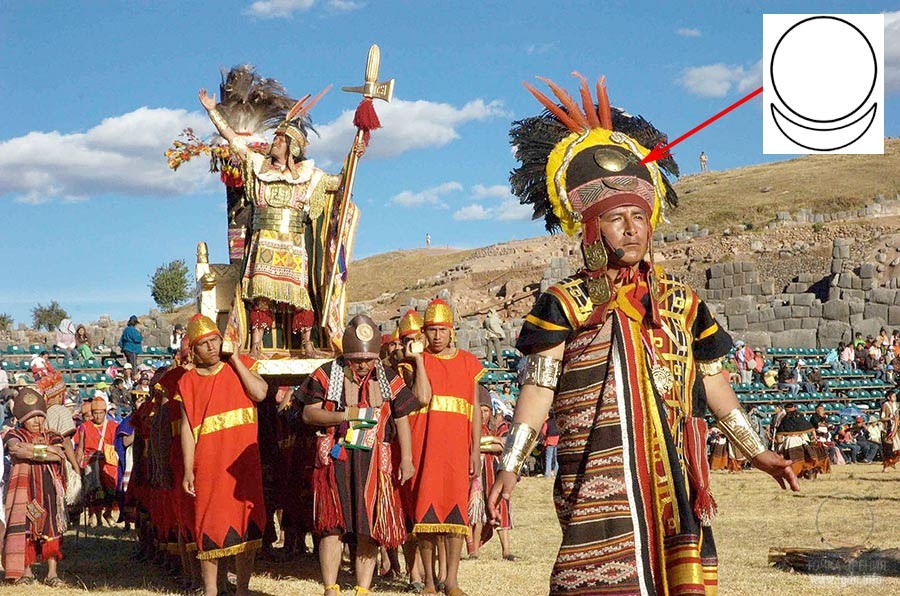
It seemed that in the early sixteenth century, before the Spanish began to demolish Peruvian culture in earnest, an idol of Viracocha had stood in the Holy of Holies of the Coricancha. According to a contemporary text, the Relacion anonyma de los costumbres antiguos de los naturales del Piru, this idol took the form of a marble statue of the god – a statue described ‘as to the hair, complexion, features, raiment and sandals, just as painters represent the apostle Saint Bartholomew’. Other accounts of Viracocha likened his appearance to that of the Saint Thomas. I examined a number of illustrated ecclesiastical manuscripts in which these two saints appeared; both were routinely depicted as lean, bearded white men, past middle age, wearing sandals and dressed in long, flowing cloaks. As we shall see, the records confirmed this was exactly the appearance ascribed to Viracocha by those who worshipped him. Whoever he was, therefore, he could not have been an American Indian: they are relatively dark-skinned people with sparse facial hair. Viracocha’s bushy beard and pale complexion made him sound like a Caucasian.
Back in the sixteenth century the Incas had thought so too. Indeed their legends and religious beliefs made them so certain of his physical type that they initially mistook the white and bearded Spaniards who arrived on their shores for the returning Viracocha and his demigods, an event long prophesied and which Viracocha was said in all the legends to have promised. This happy coincidence gave Pizarro’s conquistadores the decisive strategic and psychological edge that they needed to overcome the numerically superior Inca forces in the battles that followed.
Who had provided the model for the Viracochas?
Through all the ancient legends of the peoples of the Andes stalked a tall, bearded, pale-skinned figure wrapped in a cloak of secrecy. And though he was known by many different names in many different places he was always recognizably the same figure: Viracocha, Foam of the Sea, a master of science and magic who wielded terrible weapons and who came in a time of chaos to set the world to rights.
The same basic story was shared in many variants by all the peoples of the Andean region. It began with a vivid description of a terrifying period when the earth had been inundated by a great flood and plunged into darkness by the disappearance of the sun. Society had fallen into disorder, and the people suffered much hardship. Then ‘there suddenly appeared, coming from the south, a white man of large stature and authoritative demeanour. This man had such great power that he changed the hills into valleys and from the valleys made great hills, causing streams to flow from the living stone...’
The early Spanish chronicler who recorded this tradition explained that it had been told to him by the Indians he had travelled among on his journeys in the Andes:
And they heard it from their fathers, who in their turn had it from the old songs which were handed down from very ancient times ... They say that this man travelled along the highland route to the north, working marvels as he went and that they never saw him again. They say that in many places he gave men instructions how they should live, speaking to them with great love and kindness and admonishing them to be good and to do no damage or injury one to another, but to love one another and show charity to all. In most places they name him Ticci Viracocha...
Other names applied to the same figure included Huaracocha, Con, Con Ticci or Kon Tiki, Thunupa, Taapac, Tupaca and Illa. He was a scientist, an architect of surpassing skills, a sculptor and an engineer: ‘He caused terraces and fields to be formed on the steep sides of ravines, and sustaining walls to rise up and support them. He also made irrigating channels to flow... and he went in various directions, arranging many things.’
Viracocha was also a teacher and a healer and made himself helpful to people in need. It was said that ‘wherever he passed, he healed all that were sick and restored sight to the blind.’
This gentle, civilizing, ‘superhuman’, Samaritan had another side to his nature, however. If his life were threatened, as it seems to have been on several occasions, he had the weapon of heavenly fire at his disposal:
Working great miracles by his words, he came to the district of the Canas and there, near a village called Cacha... the people rose up against him and threatened to stone him. They saw him sink to his knees and raise his hands to heaven as if beseeching aid in the peril which beset him. The Indians declare that thereupon they saw fire in the sky which seemed all around them. Full of fear, they approached him whom they had intended to kill and besought him to forgive them... Presently they saw that the fire was extinguished at his command, though stones were consumed by fire in such wise that large blocks could be lifted by hand as if they were cork. They narrate further that, leaving the place where this occurred, he came to the coast and there, holding his mantle, he went forth amidst the waves and was seen no more. And as he went they gave him the name Viracocha, which means ‘Foam of the Sea’.
The legends were unanimous in their physical description of Viracocha. In his Suma y Narracion de los Incas, for example, Juan de Betanzos, a sixteenth-century Spanish chronicler, stated that according to the Indians, he had been ‘a bearded man of tall stature clothed in a white robe which came down to his feet and which he wore belted at the waist’.
Other descriptions, collected from many different and widely separated Andean peoples, all seemed to identify the same enigmatic individual. According to one he was:
A bearded man of medium height dressed in a rather long cloak... He was past his prime, with grey hair, and lean. He walked with a staff and addressed the natives with love, calling them his sons and daughters. As he traversed all the land he worked miracles. He healed the sick by touch. He spoke every tongue even better than the natives. They called him Thunupa or Tarpaca, Viracocha-rapacha or Pachaccan...
In one legend Thunupa-Viracocha was said to have been a ‘white man of large stature, whose air and person aroused great respect and veneration’. In another he was described as ‘a white man of august appearance, blue-eyed, bearded, without headgear and wearing a cusma, a jerkin or sleeveless shirt reaching to the knees’. In yet another, which seemed to refer to a later phase of his life, he was revered as ‘a wise counsellor in matters of state’ and depicted as ‘an old man with a beard and long hair wearing a long tunic’.
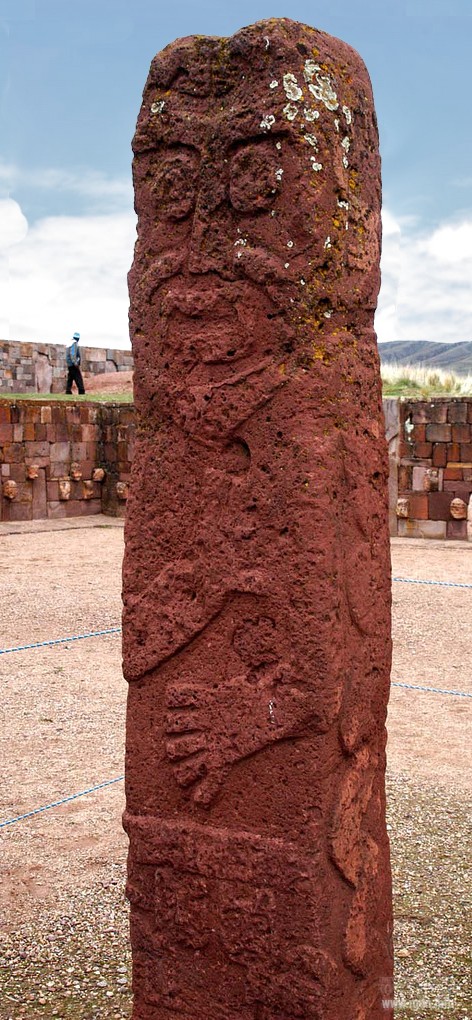 Above all else, Viracocha was remembered in the legends as a teacher. Before his coming, it was said, ‘men lived in a condition of disorder, many went naked like savages; they had no houses or other dwellings than caves, and from these they went forth to gather whatever they could find to eat in the countryside’.
Above all else, Viracocha was remembered in the legends as a teacher. Before his coming, it was said, ‘men lived in a condition of disorder, many went naked like savages; they had no houses or other dwellings than caves, and from these they went forth to gather whatever they could find to eat in the countryside’.
Viracocha was credited with changing all this and with initiating the long-lost golden age which later generations looked back on with nostalgia. All the legends agreed, furthermore, that he had carried out his civilizing mission with great kindness and as far as possible had abjured the use of force: careful instruction and personal example had been the main methods used to equip the people with the techniques and knowledge necessary for a cultured and productive life. In particular, he was remembered for bringing to Peru such varied skills as medicine, metallurgy, farming, animal husbandry, the art of writing (said by the Incas to have been introduced by Viracocha but later forgotten), and a sophisticated understanding of the principles of engineering and architecture.
I had already been impressed by the quality of Inca stonework in Cuzco. As my research in the old town continued, however, I was surprised to discover that by no means all the so-called Inca masonry could be attributed with any degree of archaeological certainty to the Incas. It was true that they had been masters in the manipulation of stone, and many monuments in the Cuzco area were indisputably their work. It seemed, however, that some of the more remarkable structures routinely attributed to them could have been erected by earlier civilizations; the evidence suggested that the Incas had often functioned as the restorers of these structures rather than their original builders.
The same appeared to be true of the highly developed system of roads connecting the far-flung parts of the Inca Empire. The reader will recall that these roads took the form of parallel highways running north to south, one along the coast and the other through the Andes. All in all more than 15,000 miles of surfaced tracks had been in regular and efficient use before the time of the Spanish conquest, and I had assumed that the Incas had been responsible for all of them. I now learned that it was much more likely that they had inherited the system. Their role had been to restore, maintain and unify a pre-existing network. Indeed, though it was not often admitted, no expert could safely estimate how old these incredible highways were or who had built them.
The mystery was deepened by local traditions which stated not only that the road system and the sophisticated architecture had been ‘ancient in the time of the Incas’, but that both ‘were the work of white, auburn-haired men’ who had lived thousands of years earlier.
One legend described Viracocha as being accompanied by ‘messengers’ of two kinds, ‘faithful soldiers’ (huaminca) and ‘shining ones’ (hayhuaypanti). Their role was to carry their lord’s message ‘to every part of the world’.
Elsewhere there were phrases such as: ‘Con Ticci returned... with a number of attendants’; ‘Con Ticci then summoned his followers, who were called viracocha’; ‘Con Ticci commanded all but two of the viracocha to go east...’; ‘There came forth from a lake a Lord named Con Ticci Viracocha bringing with him a certain number of people...’; ‘Thus those viracochas went off to the various districts which Viracocha had indicated for them...’
***
The Viracochas, said the ancient myths, the bearded, white-skinned strangers, the ‘shining ones’, the ‘faithful soldiers’.
As we travelled I continued to study the accounts of the Spanish adventurers and ethnographers of the sixteenth and seventeenth centuries who had faithfully recorded the ancient, pre-contact traditions of the Peruvian Indians. What was particularly noticeable about these traditions was the repeated emphasis that the coming of the Viracochas had been associated with a terrible deluge which had overwhelmed the earth and destroyed the greater part of humanity.
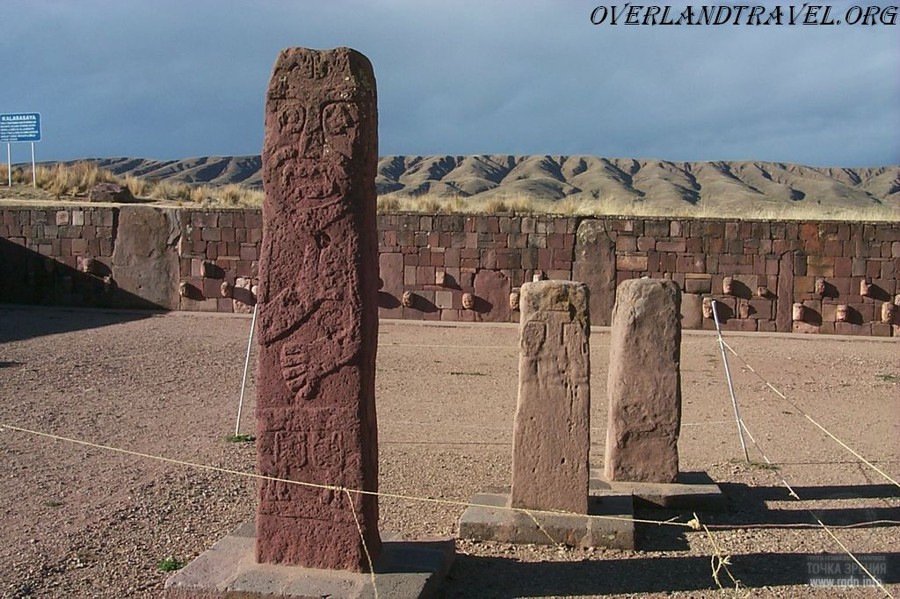
It was with understandable reluctance that I turned at last to my reading. I wanted to look more closely at some of the curious links I thought I had identified connecting the sudden appearance of Viracocha to the deluge legends of the Incas and other Andean peoples.
Before me was a passage from Fr. Jose de Acosta’s Natural and Moral History of the Indies, in which the learned priest set out ‘what the Indians themselves report of their beginning’:
They make great mention of a deluge, which happened in their country... The Indians say that all men were drowned in the deluge, and they report that out of Lake Titicaca came one Viracocha, who stayed in Tiahuanaco, where at this day there are to be seen the ruins of ancient and very strange buildings, and from thence came to Cuzco, and so began mankind to multiply...
Making a mental note to find out more about Lake Titicaca, and the mysterious Tiahuanaco, I read the following passage summarizing a legend from Cuzco area:
For some crime unstated the people who lived in the most ancient times were destroyed by the creator... in a deluge. After the deluge the creator appeared in human form from Lake Titicaca. He then created the sun and moon and stars. After that he renewed the human population of the earth...
In another myth:
The great Creator God, Viracocha, decided to make a world for men to live in. First he made the earth and sky. Then he began to make people to live in it, carving great stone figures of giants which he brought to life. At first all went well but after a time the giants began to fight among themselves and refused to work. Viracocha decided that he must destroy them. Some he turned back into stone... the rest he overwhelmed with a great flood.
Very similar notions were, of course, found in other, quite unconnected, sources, such as the Jewish Old Testament. In Chapter six of the Book of Genesis, for example, which describes the Hebrew God’s displeasure with his creation and his decision to destroy it, I had long been intrigued by one of the few descriptive statements made about the forgotten era before the Flood. According to the enigmatic language of that statement, ‘There were giants in the earth in those days...’ Could the ‘giants’ buried in the biblical sands of the Middle East be connected in some unseen way to the ‘giants’ woven into the fabric of pre-Colombian native American legends? Adding considerably to the mystery was the fact that the Jewish and Peruvian sources both went on, with many further details in common, to depict an angry deity unleashing a catastrophic flood upon a wicked and disobedient world.
On the next page of the sheaf of documents I had assembled was this Inca account of the deluge handed down by a certain Father Molina in his Relacion de las fabulas y ritos de los Yngas:
In the life of Manco Capac, who was the first Inca, and from whom they began to boast themselves children of the Sun and from whom they derived their idolatrous worship of the Sun, they had an ample account of the deluge. They say that in it perished all races of men and created things insomuch that the waters rose above the highest mountain peaks in the world. No living thing survived except a man and a woman who remained in a box and, when the waters subsided, the wind carried them… to Tiahuanaco [where] the creator began to raise up the people and the nations that are in that region…
Garcilaso de la Vega, the son of a Spanish nobleman and an Inca royal woman, was already familiar to me from his Royal Commentaries of the Incas. He was regarded as one of the most reliable chroniclers of the traditions of his mother’s people and had done his work in the sixteenth century, soon after the conquest, when those traditions had not yet been contaminated by foreign influences. He, too, confirmed what had obviously been a universal and deeply impressed belief: ‘After the waters of the deluge had subsided, a certain man appeared in the country of Tiahuanaco...’
That man had been Viracocha. Wrapped in his cloak, he was strong and august of countenance, and walked with unassailable confidence through the most dangerous badlands. He worked miracles of healing and could call down fire from heaven. To the Indians it must have seemed that he had materialized from nowhere.
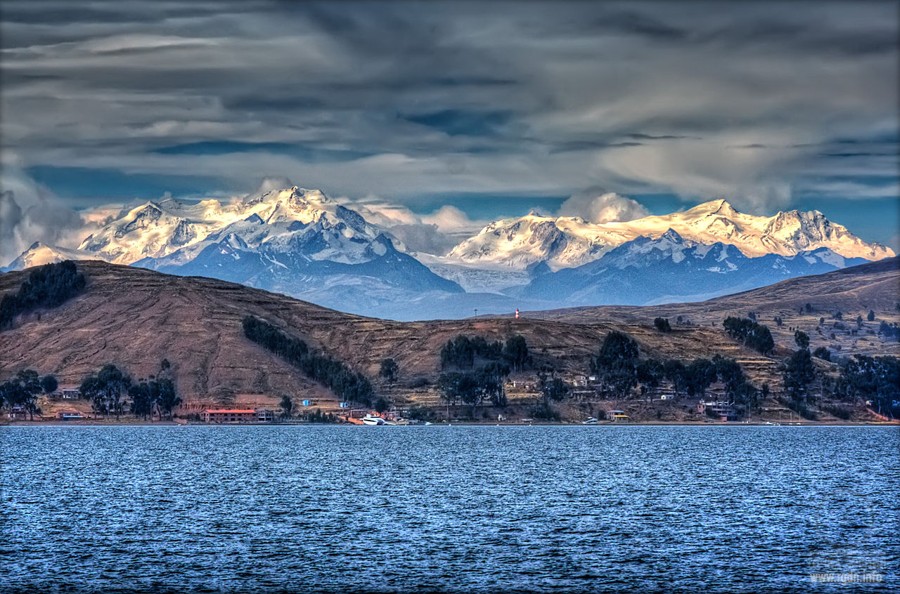
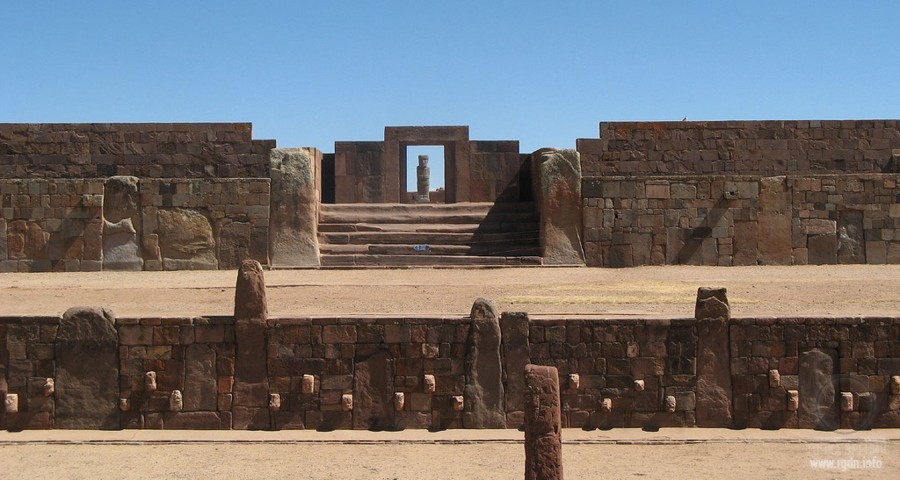
We were now more than two hours into our journey to Machu Picchu and the panorama had changed. Huge black mountains, upon which not a trace of snow remained to reflect the sunlight, towered darkly above us and we seemed to be running through a rocky defile at the end of a narrow valley filled with sombre shadows. The air was cold and so were my feet. I shivered and resumed reading.
One thing was obvious amid the confused web of legends I had reviewed, legends which supplemented one another but also at times conflicted. All the scholars agreed that the Incas had borrowed, absorbed and passed on the traditions of many of the different civilized peoples over whom they had extended their control during the centuries of expansion of their vast empire. In this sense, whatever the outcome of the historical debate over the antiquity of the Incas themselves, nobody could seriously dispute their role as transmitters of the ancient belief systems of all the great archaic cultures – coastal and highland, known and unknown – that had preceded them in this land.
And who could say just what civilizations might have existed in Peru in the unexplored regions of the past? Every year archaeologists come up with new finds which extend the horizons further and further back in time. So why shouldn’t they one day discover evidence of the penetration into the Andes, in remote antiquity, of a race of civilizers who had come from overseas and gone away again after completing their work? That was what the legends seemed to me to be suggesting, legends that most of all, and most clearly, had immortalized the memory of the man/god Viracocha striding the high windswept byways of the Andes working miracles wherever he went:
Viracocha himself, with his two assistants, journeyed north... He travelled up the cordillera, one assistant went along the coast, and the other up the edge of the eastern forests... The Creator proceeded to Urcos, near Cuzco, where he commanded the future population to emerge from a mountain. He visited Cuzco, and then continued north to Ecuador. There, in the coastal province of Manta, he took leave of his people and, walking on the waves, disappeared across the ocean.
There was always this poignant moment of goodbye at the end of every folk memory featuring the remarkable stranger whose name meant ‘Foam of the Sea’:
Viracocha went on his way, calling forth the races of men... When he came to the district of Puerto Viejo he was joined by his followers whom he had sent on before, and when they had joined him he put to sea in their company and they say that he and his people went by water as easily as they had traversed the land.
Always this poignant goodbye… and often a hint of science or magic.
During my travels in the Andes I had several times re-read a curious variant of the mainstream tradition of Viracocha. In this variant, which was from the area around Lake Titicaca known as the Collao, the deity civilizing-hero had been named Thunupa:
Thunupa appeared on the Altiplano in ancient times, coming from the north with five disciples. A white man of august presence, blue-eyed, and bearded, he was sober, puritanical and preached against drunkenness, polygamy and war.
After travelling great distances through the Andes, where he created a peaceful kingdom and taught men all the arts of civilization, Thunupa was struck down and grievously wounded by a group of jealous conspirators:
They put his blessed body in a boat of totora rush and set it adrift on Lake Titicaca. There ... he sailed away with such speed that those who had tried so cruelly to kill him were left behind in terror and astonishment – for this lake has no current ... The boat came to the shore at Cochamarca, where today is the river Desguardero. Indian tradition asserts that the boat struck the land with such force it created the river Desguardero, which before then did not exist. And on the water so released the holy body was carried many leagues away to the sea coast at Africa.
There are curious parallels here to the story of Osiris, the ancient Egyptian high god of death and resurrection. The fullest account of the original myth defining this mysterious figure is given by Plutarch and says that, after bringing the gifts of civilization to his people, teaching them all manner of useful skills, abolishing cannibalism and human sacrifice, and providing them with their first legal code, Osiris left Egypt and travelled about the world to spread the benefits of civilization to other nations as well. He never forced the barbarians he encountered to accept his laws, preferring instead to argue with them and to appeal to their reason. It is also recorded that he passed on his teachings to them by means of hymns and songs accompanied by musical instruments.
While he was gone, however, he was plotted against by seventy-two members of his court, led by his brother-in-law Set. On his return the conspirators invited him to a banquet where a splendid coffer of wood and gold was offered as a prize to any guest who could fit into it exactly. Osiris did not know that the coffer had been constructed precisely to his body measurements. As a result, when the assembled guests tried one by one to get into it they failed. Osiris lay down comfortably inside. Before he had time to get out the conspirators rushed forward, nailed the lid tightly closed and sealed even the cracks with molten lead so that there would be no air. The coffer was then thrown into the Nile. It had been intended that it should sink, but it floated rapidly away, drifting for a considerable distance until it reached the sea coast.
At this point the goddess Isis, wife of Osiris, intervened. Using all the great magic for which she was renowned, she found the coffer and concealed it in a secret place. However, her evil brother Set, out hunting in the marshes, discovered the coffer, opened it and, in a mad fury, cut the royal corpse into fourteen pieces which he scattered throughout the land.
Once more Isis set off to save her husband. She made a small boat of papyrus reeds, coated with pitch, and embarked on the Nile in search of the remains. When she had found them she worked powerful spells to reunite the dismembered parts of the body so that it resumed its old form. Thereafter, in an intact and perfect state, Osiris went through a process of stellar rebirth to become god of the dead and king of the underworld – from which place, legend had it, he occasionally returned to earth in the guise of a mortal man.
Although there are huge differences between the traditions it is bizarre that Osiris in Egypt and Thunupa-Viracocha in South America should have had all of the following points in common:
Are such parallels to be dismissed as coincidences? Or could there be some underlying connection?
***
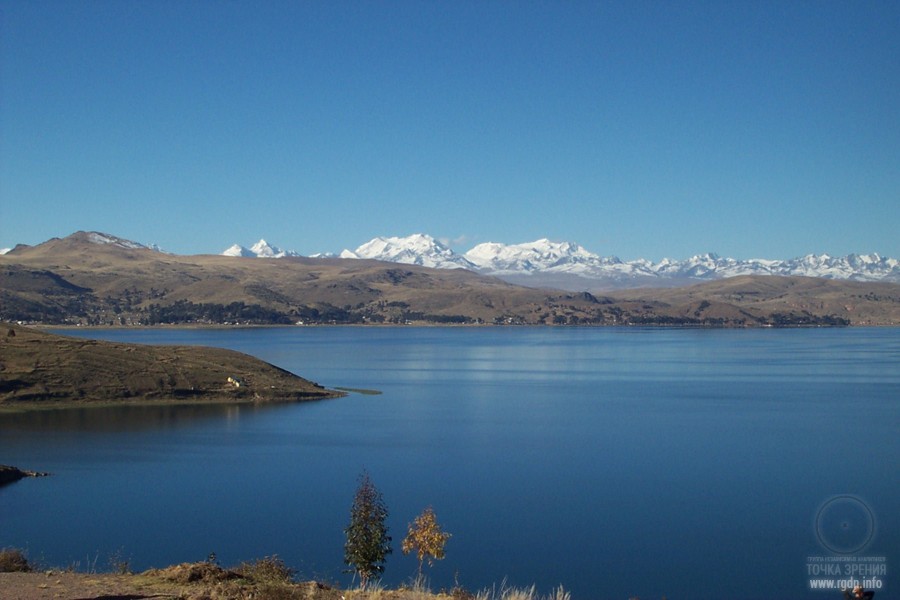
The image I could not get out of my mind was of the Viracocha people leaving, ‘walking on the waters’ of the Pacific Ocean, or ‘going miraculously’ by sea as so many of the legends told.
Where had these seafarers been going? What had their objective been? ...
After several weeks work on the Altiplano, travelling back and forth between La Paz and Tiahuanaco, it became clear that neither the otherworldly ruins nor the libraries of the capital were going to provide me with any further answers. Indeed, in Bolivia at least, the trail seemed to have gone cold…
It was not until I reached Mexico, 2000 miles north, that I picked up its traces again...
From Fingerprints of the Gods by Graham Hancock
Prepared by Dato Gomarteli (Ukraine-Georgia)
 Viracocha. The One who came in a time of chaos
votes:
214
Viracocha. The One who came in a time of chaos
votes:
214
|

Project Aim










Leave comment